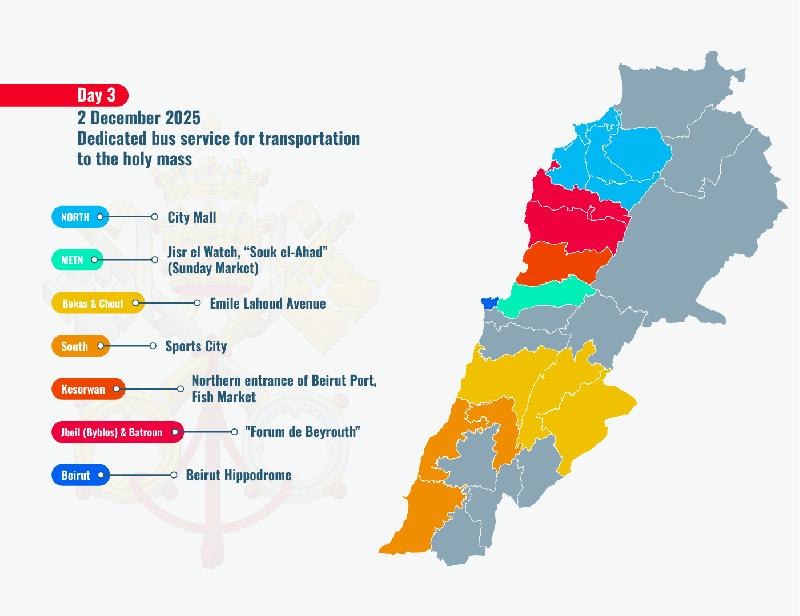
The official commission in charge of organizing Pope Leo XIV’s visit held a press briefing on Tuesday to inform citizens and the media about the planned logistical, security-related and media arrangements. It also detailed the routes that the papal convoy will follow during the three-day visit to Lebanon (November 30-December 2). The conference took place in the honor hall of the Republican Guard regiment, in building No. 4 of the presidential palace in Baabda.
Rafic Chlela, director of the presidential palace press office, announced that 1,350 Lebanese and foreign journalists have registered to cover the visit.
During these three days, the Harissa area will be closed to the public; the cable car will be suspended, and paragliding will be prohibited. No access will be allowed around the pope’s residence – the Apostolic Nunciature in Harissa – except for residents of Sahel Alma.
Day 1: Roads Closed During the Convoy’s Passage
General Joseph Moussallem, head of the public relations division of the Internal Security Forces, detailed the itinerary for the first day of the visit, Sunday, November 30. The pope will arrive at the airport, then go to the presidential palace, and afterward to the Apostolic Nunciature. The roads will be closed only shortly before the convoy passes, and reopened immediately after.
According to the organizing commission, 21 artillery salutes will be fired when the pope arrives in Beirut.
Day 2: Transportation Measures and Gathering Points
General Moussallem said that traffic measures will be implemented on Monday, December 1, around the Monastery of Saint Maron. Several parking lots for buses transporting the faithful will be set up before the army checkpoint in Annaya, as well as on the road to the hermitage, the Michmich road, and the Hjoula–Fidar road.
He called for all vehicles around the monastery and along the mentioned roads to be cleared the day before the visit.
The general also stated that traffic measures will be implemented to facilitate access to the patriarchal seat in Bkerkeh. The faithful will have to leave from their respective dioceses toward predefined gathering points before being transported to Bkerkeh.
The gathering points are as follows:
-
Holy Spirit University of Kaslik: for arrivals from Metn, Beirut, the Bekaa, and the South
-
Notre-Dame of Bzoummar Monastery: for arrivals from Keserwan
-
Casino du Liban: for arrivals from the North, Batroun, and Jbeil
-
Fouad Chehab Stadium: for priests, journalists, and holders of special invitations without drivers
-
Deir el-Cherfeh Monastery: parking reserved for faithful arriving with a driver, upon special invitation
In addition, traffic on the Beirut waterfront will be blocked starting at 8 p.m., on the eve of the solemn mass that will be celebrated there on Tuesday.
Day 3: Solemn Mass at 10:30 a.m.
The schedule for the progressive closure of roads in downtown Beirut for the December 2 mass will be carried out in three phases:
-
Monday, December 1 at 8 p.m.: closure of the waterfront
-
Monday at midnight: closure of businesses around the port, Saifi, the An-Nahar building, Bab Idriss, Fakhreddine, and Saint-Georges
-
Tuesday, December 2 at 4 a.m.: extension of road closures toward Gemmayzeh, Bechara el-Khoury, and the Ring area
Checkpoints will be installed at all entrances to the zone, and the use of drones will be strictly prohibited.
Citizens are invited to arrive from 5 a.m. to attend the mass in Beirut. Parking areas are planned for buses coming from different regions, followed by shuttle transfers to the site of the mass.
The commission indicated that more than 120,000 faithful are expected to attend. In case of rain, participants are advised to bring umbrellas.






Comments